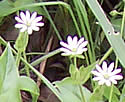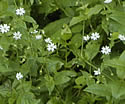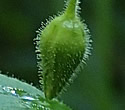Myosoton aquaticum (Giant Chickweed)
| Also known as: | |
|---|---|
| Genus: | Myosoton |
| Family: | Caryophyllaceae (Pink) |
| Life cycle: | perennial |
| Origin: | Europe |
| Status: |
|
| Habitat: | part shade; moist soil, thickets, along shores |
| Bloom season: | May - October |
| Plant height: | 6 to 24 inches |
| Wetland Indicator Status: | GP: FAC MW: FACW NCNE: FAC |
| MN county distribution (click map to enlarge): |  |
| National distribution (click map to enlarge): |  |
Pick an image for a larger view. See the glossary for icon descriptions.
Detailed Information
Flower: 
![[photo of flowers]](/udata/r9ndp23q/white/giant-chickweed-100_5560-t.jpg) ½-inch white flowers arising from leaf axils and at the tips of branching stems. Flowers have 5 petals that are deeply divided so they look like 10. 10 white-tipped stamens surround a green ovary with 5 short, arching white styles at the top.
½-inch white flowers arising from leaf axils and at the tips of branching stems. Flowers have 5 petals that are deeply divided so they look like 10. 10 white-tipped stamens surround a green ovary with 5 short, arching white styles at the top.
![[photo of sepals and glandular hairs]](/udata/r9ndp23q/pd/myosoton-aquaticum-789379-12-t.jpg) The 5 green sepals are a little shorter than the petals, narrowly egg-shaped with a blunt tip. The sepals and flower stalks are covered with glandular hairs.
The 5 green sepals are a little shorter than the petals, narrowly egg-shaped with a blunt tip. The sepals and flower stalks are covered with glandular hairs.
Leaves and stem: 

![[photo of leaves]](/udata/r9ndp23q/white/myosoton-aquaticum-giant-chickweed_0605_103958-t.jpg) Leaves are egg to heart-shaped, up to 2½ inches long and 1 inch wide, toothless and often wavy around the edges. The lowest leaves are short-stalked but the upper leaves are stalkless or nearly so, and may clasp the stem. Attachment is opposite, with leaf pairs at right angles to the pair above and below. The upper leaves and stems are covered in glandular hairs, the lower more likely hairless. Stems are many branched and weak, typically sprawling on surrounding vegetation for support.
Leaves are egg to heart-shaped, up to 2½ inches long and 1 inch wide, toothless and often wavy around the edges. The lowest leaves are short-stalked but the upper leaves are stalkless or nearly so, and may clasp the stem. Attachment is opposite, with leaf pairs at right angles to the pair above and below. The upper leaves and stems are covered in glandular hairs, the lower more likely hairless. Stems are many branched and weak, typically sprawling on surrounding vegetation for support.
Fruit: 
![[photo of fruit]](/udata/r9ndp23q/white/myosoton-aquaticum-giant-chickweed_0813_102919-t.jpg) Fruit is an oval capsule about as long as or a little longer than the sepals. As fruit develops, the flower stalk nods with the capsule hanging down at the tip. When ripe, the capsule splits open at the tip releasing numerous round, rusty brown seeds.
Fruit is an oval capsule about as long as or a little longer than the sepals. As fruit develops, the flower stalk nods with the capsule hanging down at the tip. When ripe, the capsule splits open at the tip releasing numerous round, rusty brown seeds.
Notes:
A common weed of disturbed soils.
Native Plant Nurseries, Restoration and Landscaping Services ↓
More photos
 Giant Chickweed plant
Giant Chickweed plant dense patch of leaves
dense patch of leaves Giant Chickweed plants
Giant Chickweed plants Giant Chickweed plants
Giant Chickweed plants dangling fruits
dangling fruits
Photos by K. Chayka taken in Anoka, Chisago and Ramsey counties. Photos courtesy Peter M. Dziuk taken in Chisago County.
Comments
Have you seen this plant in Minnesota, or have any other comments about it?
on: 2012-06-11 22:00:15
I have photos of the flowers if there is any need.
on: 2015-10-17 09:27:00
The Giant Chickweed is common around our lake cabin. It's attractive, and doesn't seem invasive. Yet.
on: 2016-11-01 13:28:57
Chickweed can form dense colonies and smother new vegetation, as witnessed in the first growing seasons of several wetland restorations in the northern metro suburbs. But in other areas it has been observed as a few singular plants in a patch of diverse shoreline/wetland vegetation. Seems to proliferate with more disturbance.
on: 2022-10-02 20:16:05
Bottom land along the Snake River. October 2, 2022
on: 2022-11-01 09:46:53
Several years after buckthorn removal. Had ignored this but am now being overrun by it, especially in lower areas. Need control advice. Thanks!
on: 2023-09-03 20:59:04
Does Gaint Chickweed have the Mohawk Hairs that Common Chickweed has? From the Pics, It didn't look like it but I want to confirm. Could Myosoton aquaticum be the result of 2 genera crossing? Myosoton is a monotypic genus (As with many Monotypic genera being made after 2 genera cross) making me suspect it to be the case here. If so, do you know if Myosoton can Cross with Stellaria? Do you know where I can find out, or if you have any links to phylogenic trees I can look at it?
on: 2023-09-04 09:54:01
John, as seen in some of the photos, the giant chickweed stem does not have a row of hairs, but it is sufficiently different from common chickweed (much larger in all respects, for one) that that should not be mistaken for each other. Regarding hybrids, Minnesota Wildflowers has no knowledge or expertise regarding most hybrids, including those you mentioned. Those questions are better posed to a horticulturist.
on: 2023-09-06 13:47:15
Do you know any Horticulturist or Plant Breeding Experts I can ask? Or anyone who specializes in Chickweed Taxonomy/Phylogenic Trees? So far, This Website has the most straight Forward Knowledge on Chickweed Differences I've found. So Thank You!
on: 2023-09-07 08:18:14
John, sorry but we do not know anyone expert in this species.






